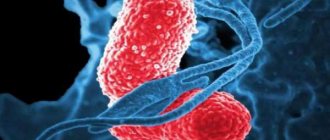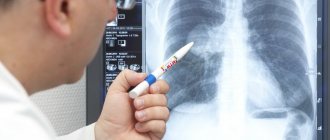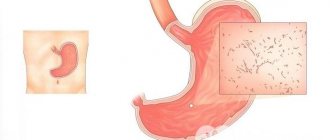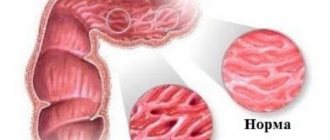Inflammation in the lungs is severe and difficult to treat. Left-sided pneumonia is especially difficult to tolerate. This is due to the anatomical structure of the internal organ and the close location of the heart. If the condition is neglected and the body is weakened, the disease can lead to death. You need to know the signs of pathology in order to start treatment on time.
Forms and types of disease
Classification of lower lobe pneumonia is made according to the prevalence of the pathological process, as well as according to the conditions of occurrence. In the first case, the disease is divided into the following forms:
- Croupous - involves the entire lobe of the lung, is distinguished by the most severe course and pronounced clinical picture.
- Bronchopneumonia (focal) – one or more foci of inflammation are formed in the hilar zone of the lung, which can merge with each other. The course of the disease is mild, self-destruction often occurs without medical help.
- Segmental - is an intermediate option with an appropriate course. The severity of clinical symptoms depends on the number of affected segments.
According to the conditions for the occurrence of pneumonia, they are divided into such varieties as:
- Community-acquired - develop in everyday life against the background of provoking factors, in particular hypothermia. In most cases, the causative agent is pneumococcus, intracellular parasites, Haemophilus influenzae, and influenza virus. They have good sensitivity to antibiotics and are relatively easy to treat.
- Nosocomial - develops while in hospital. The likelihood of illness increases by orders of magnitude while the patient is on mechanical ventilation, during intubation, bronchoscopy and other invasive manipulations on the organs of the respiratory system. The causative agent is usually gram-negative flora, which is resistant to most antibacterial drugs. The course of hospital-acquired pneumonia is severe, often with complications.
- Aspiration – occurs when swallowing vomit and washing water. The causative agent is obligate anaerobes that populate the human intestine, as well as aerobic microorganisms that normally live in the nasopharynx. It often develops in the absence of a cough reflex, as well as in unconscious people. It responds relatively well to antibiotic therapy.
- Pneumonia due to immunodeficiency - pneumonia that develops against the background of severe immunodeficiency is usually provoked by opportunistic organisms that normally live in the body and do not lead to inflammation in a healthy person. The causative agent can be carinobacteria, fungi, and mycobacterium tuberculosis. To prescribe adequate therapy, microflora culture and precise identification of the pathogen are required.
There are other classifications of the disease. However, the above division parameters are the most popular and reflect the essence of the pathological process.
Note: for the treatment of severe hospital pneumonia that is not amenable to antimicrobial therapy, bacteriophages are used - bacterial cell viruses, cell parasites. They multiply only in the m/o's body, causing his death. After all bacteria are destroyed, the bacteriophage culture dies.
Classification
| By localization |
|
| By symptoms |
|
| According to the location of the source of inflammation |
|
Features of the clinical picture
During the initial examination of the patient, some features of lower lobe pneumonia should be taken into account, which may complicate the diagnosis.
Right lower lobe pneumonia
The type in question can occur in the abdominal form, in which pain radiates to the abdomen. In this case, the patient’s complaints resemble those with diseases of the liver and gall bladder. There are known cases of erroneous diagnosis of the initial stage of appendicitis (epigastric pain), the cause of which was right-sided lower lobe pneumonia.
Left-sided lower lobe pneumonia
Left-sided lesions can also cause abdominal pain. However, in this case they are localized in the left hypochondrium, simulating diseases of the left lobe of the liver, spleen, diaphragm, colon, including its transverse and descending sections.
It is worth noting that the described variants of the clinical course occur only with common segmental or lobar processes. Focal pneumonia rarely leads to the development of pain. A distinctive feature of the abdominal course is a pronounced inflammatory clinic, against the background of which relatively mild pain and the absence of other signs of pathology of the internal organs appear.
Right-sided pneumonia in children - features of the course of the disease
A child’s weak immune system significantly increases the risk of developing inflammation. This is mainly influenced by the age of the baby, that is, the younger he is, the higher the risk of the disease. A big danger is the misdiagnosis of the disease. Pneumonia is often confused with the flu, causing it to develop into a dangerous stage. Therefore, it is so important to know the symptoms typical of this disease.
As right-sided pneumonia enters the active phase, the child’s breathing becomes rapid and hoarse. Discomfort and cough interfere with normal functioning. Lethargy and drowsiness appear, and sleeping on the right side gives the baby discomfort. The elevated temperature lasts a long time and is very difficult to overcome. There is a feeling of lack of air, and in some cases coughing up blood or pus occurs.
The presence of one of the symptoms should be a reason to visit a doctor, because any delay is very dangerous for the child’s health. In advanced cases, medications do not always help; therefore, the baby is prescribed hospitalization.
Read the article: Is it possible to walk with pneumonia?
Diagnostics
Clinical manifestations of lower lobe pneumonia depend on its prevalence and can vary quite widely. The entire set of clinical symptoms is divided into general and local signs.
General ones depend not on the localization of the process, but on its prevalence. Minor focal pneumonia can be manifested by coughing, a rise in body temperature within the subfebrile range, and deterioration in performance. Chest pain usually does not occur.
Croupous processes begin acutely. The patient complains of a painful dry cough, which becomes productive by 3-4 days. The sputum may be mucopurulent or have a rusty tint, which is due to the destruction of the red blood cells it contains. Hyperthermia up to 39-40°C is noted. There is shortness of breath, pain in the chest on the affected side, and lag of the affected area when breathing. Listening reveals dullness and shortening of percussion sounds and the presence of wheezing.
The course of segmental pneumonia depends on how many segments are affected by inflammation. If their number approaches the maximum (6-8 segments), then the disease proceeds with a clinical picture resembling the croupous variety. Damage to 2-5 segments manifests itself somewhat more intensely than a limited focal process, but does not reach the intensity characteristic of damage to the entire lobe or a significant part of it.
Instrumental methods
The diagnosis is made using instrumental methods, the main of which is radiography. In case of lobar pneumonia, the images reveal an increase in the pulmonary pattern, expansion of the root, and an upward change in the volume of the affected lobe. With bronchopneumonia, the presence of one or more shadows is noted, each of which does not exceed one and a half centimeters in size. Shadows can merge. X-rays are performed in frontal and lateral projections, which increases the accuracy of the study.
X-ray of lower lobe pneumonia
In addition to the described method, additional diagnostic procedures may be required for pneumonia. These include:
- Bronchoscopy is a visual examination of the airways using endoscopic equipment.
- Brush biopsy and bronchoalveolar lavage - allow you to obtain the biological media necessary for inoculating microflora.
- Pulmonary function testing is required to determine the degree of airway obstruction.
- Computed tomography - allows you to determine the presence of cavitary formations and bronchiectasis. Prescribed only if there is suspicion of these conditions.
Additional diagnostic procedures are used as necessary. X-rays are performed in all patients without exception.
Laboratory confirmation
A general blood test reveals nonspecific signs of inflammation (a shift of the leukocyte formula to the left, an increase in the erythrocyte sedimentation rate, and in severe pneumonia - a predominance of myelocytes and metamyelocytes). Changes in biochemical parameters occur only during common processes, but they have practically no diagnostic value.
Microbiological culture of sputum is performed in cases where it is necessary to accurately determine the type of pathogen. As a rule, this happens in hospital-acquired antibiotic-resistant forms, processes that develop against the background of immunodeficiency states. In other situations, antibiotics are prescribed empirically. This approach has an economic rationale and is associated with the requirement to reduce the costs of diagnosis and treatment.
Note: ideally, the prescription of antibacterial agents should be made strictly according to the data of a microbiological study. The empirical method of selecting drugs is allowed only at the initial stages of therapy, when data on the composition of the microflora and its sensitivity to drugs are not yet available.
Upper lobe pneumonia: how to treat
As a rule, it begins suddenly. With upper lobe pneumonia, a headache and a feeling of chills appear. A little later the temperature rises to 39 degrees. Pain in the chest area and severe shortness of breath are other important symptoms of a disease such as upper lobe pneumonia. Find out how to treat it in this article.
Upper lobe pneumonia: development of the disease
There may be a violation of geodynamics and the appearance of a delirious state. Starting from the first days of illness, a dry cough appears, then turns into a productive cough with sputum. Rashes on the lips, in the form of herpes, hyperemia on the face, and cyanosis were often noticed. There are yellow spots on the skin and sclera on the eyes due to an increase in bilirubin in the blood. This disease, with the symptoms described above, is observed in children and older people.
Upper lobe pneumonia: how to treat the disease
Upper lobe pneumonia is of bacterial origin. The disease is very severe when affected by Klebsysla. When treatment for upper lobe pneumonia is started very late, cavities can form. Upper lobe pneumonia should be differentiated from pulmonary tuberculosis. If antibacterial treatment is prescribed, it should be started without delay, and the doctor during the examination does not wait for test results, but immediately prescribes antibiotics. Self-medication is strictly contraindicated.
With the right choice of therapy, upper lobe pneumonia can be successfully treated in 5-7 days. During this time, the temperature drops, hallucinations pass, and appetite appears. With left-sided upper lobe pneumonia, the level of C-reactive protein increases, this is the main cause of the inflammatory process. The localization of the focus of pneumonia in the upper lobe of the lung may well be due to infection with tuberculosis. In this case, treatment with standard therapy is used with the goal of stopping the focus of the inflammatory process. After treatment, the disease is monitored using x-rays.
Upper lobe pneumonia: how to treat in a hospital
Right-sided upper lobe pneumonia is very rare. A very severe course of upper lobe pneumonia caused by Klebsis pneumonia (Friedlander's bacillus). Pneumonia is not a contagious disease, and it is important for staff to monitor all changes that are currently occurring in the patient: temperature, blood pressure. During attacks of mental agitation, the patient is monitored.
Today, pneumococcal and influenza vaccines are used to prevent upper lobe pneumonia. All preventive measures are applied according to risk groups.
AstroMeridian.ru
Possible complications
With pneumonia, which is not treated or treated incorrectly, complications are common. The most common of them include:
- Exudative pleurisy is inflammation of the pulmonary pleura with the release of exudate into the pleural cavity.
- Secondary infectious lesions - hematogenous spread of infection causes myocarditis, pyelonephritis and other things.
- Infectious-toxic shock is a condition that develops when a large amount of bacterial toxins enters the blood and is characterized by a sharp decrease in blood pressure, centralization of blood circulation, disturbances in heart rhythm, breathing and consciousness.
- Respiratory failure is insufficient efficiency of the respiratory system, leading to tissue ischemia.
- DIC syndrome is a coagulopathy characterized by the initial formation of microthrombi in the bloodstream followed by depletion of coagulation factors.
- Acute psychosis – against the background of the toxic effect of the pathogen in lobar lower lobe pneumonia, the development of mental disorders is possible.
Almost each of the above complications is life-threatening and requires immediate hospitalization of the patient in the ICU.
How is right-sided pneumonia diagnosed?
If right-sided pneumonia is suspected, symptoms alone are not enough to accurately diagnose the disease. As a rule, an X-ray examination of the lungs is performed. If necessary, urine and blood tests are carried out, based on which the occurrence of the disease is assessed.
Lower lobe pneumonia - treatment
Treatment of pneumonia can be carried out both on an outpatient basis and in a hospital setting.
Inpatient care is provided to patients with severe disease (respiratory rate above 30 times/minute, unstable hemodynamics, critical hyperthermia), as well as people over 60 years of age or in the absence of effect from outpatient treatment for 2-3 days. Patients with signs of shock or severe respiratory failure (hypotension, SpO2 less than 80%, disseminated intravascular coagulation syndrome) are placed in the intensive care unit. The treatment of pneumonia, including lower lobe pneumonia, is based on the use of antibacterial drugs. Community-acquired processes allow the use of semi-synthetic penicillins or cephalosporins, hospital processes and those caused by immunodeficiency - fluoroquinolones, aminoglycosides, macrolides. In addition to a/b, patients receive bronchodilators, expectorants, and anti-inflammatory drugs.
Resuscitation benefits for patients with severe forms of pneumonia and respiratory failure consist of the administration of immunized plasma, immunoglobulins, correction of hematocrit, and administration of hormones. If necessary, the patient is transferred to mechanical ventilation and the administration of vasopressor amines is started. Relief of shock conditions is carried out under constant monitoring of vital signs (heart rate, blood pressure, saturation level, body temperature).
The duration of therapy in outpatients usually does not exceed 7-14 days, which is equal to the duration of a full course of antibiotics. Mucolytics can be taken for a slightly longer period, relieving residual cough and accelerating its disappearance. A similar time is required for the recovery of hospitalized patients. The recovery period (outpatient follow-up treatment) reaches 1 month. It is not possible to predict the length of hospital stay for intensive care patients. Some patients are transferred to the general ward within a few days after hospitalization, others remain in the ICU for a month or more.
Treatment
Since there are several forms of varying severity, right-sided pneumonia is treated differently. The average degree involves inpatient treatment, but treatment options at home are also possible. If this is a severe form, then hospitalization is required. You should not abandon this measure, even if you do not feel any significant changes in your condition. If there are indications, an x-ray shows darkening in the lung area, then only under the supervision of doctors and with regular medication can a positive result be achieved. Most deaths occur with late-diagnosed and untreated community-acquired pneumonia.
The acute form manifests itself with active symptoms, so the patient consults a doctor as soon as possible. This promotes a speedy recovery. In the chronic course of the disease, not only the lung tissue is affected, but also the intermediate tissue, which leads to the formation of pathological processes. Connective tissues may grow, the bronchi may become deformed, and respiratory failure may occur.
Antibiotics are practically the only effective treatment for inflammation of the right lung, and for all other forms of the disease. To achieve a positive result of the therapy, it is necessary to know the nature of the origin of the infection, since an integrated approach and combination of several treatment methods may be necessary. If sputum begins to leave, expectorants, immunomodulators and antipyretics are prescribed.
It is recommended to drink plenty of fluids, tea with bee products, and lemon. Nutrition should be complete and rich in vitamins. The food is not fatty, so that digestion does not take away energy during digestion, bed rest.
There are a number of factors to determine whether hospitalization is required. This is acute respiratory failure, uremia, hypotension, loss of consciousness.
The duration of treatment is 10 days; for mild forms, tablets are acceptable, and for severe forms, droppers are given and intramuscular injections are prescribed.
Prognosis and prevention
The prognosis for focal and segmental pneumonia is favorable if treatment was started on time. In the absence of antimicrobial therapy, the process quickly invades the lower lobe of the lung and continues to spread, ultimately leading to the death of the patient. It is impossible to predict the outcome of lobar inflammation. Much depends on the initial state of health of the patient, the level of his immune defense, and adherence to treatment. It is known that the mortality rate from community-acquired pneumonia is 5%, from hospital-acquired pneumonia – 20%. Approximately 30% of deaths occur among elderly people.
Prevention of pneumonia mainly includes measures to strengthen the immune system (hardening, vitamin therapy, healthy lifestyle, and, if necessary, taking immunomodulators). In addition, the disease can be prevented if you always dress appropriately for the weather, avoid staying in crowded places in spring and autumn, visit a doctor in a timely manner and begin treatment for acute respiratory infections and acute respiratory viral infections.
Prevention
Today there is a preventive program designed for risk groups, pensioners and people with chronic diseases. In Europe and the USA, vaccinations have long become an integral part of prevention. In Russia, similar measures have only recently begun to be applied.
A healthy lifestyle is absolutely recommended for everyone, since only with good immunity pathogens will not be able to become active, or will be quickly suppressed.
The treatment regimen and prevention depend on individual characteristics, so the doctor approaches this issue carefully. You should stop drinking alcohol and limit smoking if possible. The condition of the teeth also plays a role, and if there are pockets of caries, it is imperative to eliminate them.
Treatment with folk remedies will not be able to defeat the disease, but it can relieve the symptoms of the disease, nasal congestion, sore throat and others.
Right-sided pneumonia: causes, symptoms and treatment
Pneumonia is a rather serious disease, which, unfortunately, affects all categories of the population, regardless of gender and age. Before the advent of the first antibiotics, right-sided pneumonia resulted in the death of every third patient. Fortunately, modern medicine has all the necessary means of treatment, so the prognosis for patients is quite favorable.
Right-sided pneumonia and its causes
Most often, the cause of the inflammatory process is an infection - it can be bacteria, viruses and even fungal microorganisms transmitted from person to person by airborne droplets.
In addition, the source of pathogenic microflora may be in the body itself. In particular, the risk group includes people with chronic respiratory diseases, including tonsillitis, sinusitis, bronchitis, etc. The development of pneumonia is facilitated by a weakened immune system. Poor nutrition, hypothermia, constant stress, previous acute respiratory infections and colds - all this increases the chances of developing an inflammatory process.
Right-sided pneumonia and its main symptoms
The initial stages of the disease are often confused with a common cold - patients simply ignore the symptoms and do not seek help from a doctor, which only worsens the situation. However, acute right-sided pneumonia has some features that should never be ignored.
The disease begins with an increase in temperature, which entails weakness, drowsiness, body aches, constant fatigue, and loss of appetite. But unlike the flu and other colds, with pneumonia the fever lasts much longer.
Naturally, one of the symptoms of pneumonia is a severe cough, accompanied by the discharge of viscous sputum (sometimes it has an orange, rusty tint). As the disease progresses, a noticeable pain appears behind the sternum or in the side, which intensifies during a deep breath or cough.
Right-sided pneumonia is necessarily accompanied by persistent shortness of breath, which appears even with the slightest physical exertion.
An atypical form of inflammation is also possible, which is considered the most dangerous, since it occurs without pronounced symptoms and therefore does not cause concern to a sick person.
What causes contribute to the development of lobar pneumonia
The main causative agent of the lobar form of pneumonia is pneumococcus and its varieties. But this disease can develop under the influence of other microorganisms:
- streptococcus;
- staphylococcus;
- Haemophilus influenzae;
- mycoplasmas;
- chlamydia.
If the causative agent of the inflammatory process cannot be identified, the patient is diagnosed with unspecified lobar pneumonia.
The source of infection can live in the human nasopharynx for a long time and become active only under the influence of certain factors.
Pathogenic viruses and bacteria can enter the lungs of a patient in several ways:
- through the bronchi;
- through blood;
- through lymph.
There are certain diseases that increase the risk of developing lobar pneumonia. These include:
- diabetes mellitus and other autoimmune diseases;
- pulmonary pathologies, including tuberculosis;
- influenza and other acute viral respiratory infections;
- oncological processes in the respiratory organs.
But even in the presence of one or more of these pathological conditions, lobar pneumonia does not always develop. Pathogenic microorganisms begin to actively multiply only with significant immunodeficiency caused by the following factors:
- prolonged hypothermia;
- frequent stress;
- smoking and alcohol abuse;
- chest injuries;
- physical and psychological overload;
- harmful working conditions;
- unfavorable living conditions (here the provoking factor is dampness in the room and the formation of mold).
What treatment methods are effective for lobar pneumonia
If lobar pneumonia is suspected, the patient is admitted to a hospital and prescribed broad-spectrum antibiotics, to which most pathogenic microorganisms are sensitive. The most commonly used drugs are from the penicillin group. If they are intolerant, the patient is prescribed antibiotics from the group of cephalosporins and macrolides.
Other medications are also prescribed:
- drugs that expand the lumen of the bronchi and dilute sputum;
- agents with antipyretic and anti-inflammatory effects;
- immunomodulators;
- vitamin and mineral complexes.
Physiotherapy is effective in the treatment of pneumonia, including the following procedures:
- electrophoresis and inhalation with drugs;
- UHF;
- Exercise therapy and cage chest massage.
If the patient is admitted to the hospital in serious condition, he is connected to a ventilator, therapeutic bronchoscopy and hyperbaric oxygenation are performed.
If conservative therapy is ineffective, a surgical operation is performed, during which the affected part of the lung is removed.
Community treatment
If signs of the disease are detected, it is extremely dangerous to engage in therapy on your own. This can lead to serious health problems. To prescribe effective treatment, you should consult a doctor.
For the treatment of adults, a doctor prescribes highly effective antibacterial drugs that reduce the inflammatory process in the lungs of an adult or child.
Left-sided pneumonia is subject to therapeutic intervention according to the following scheme:
- Antibiotics: Amoxicillin, Cephalosporin, Levafloxacin. The selection of medications is carried out according to specific pathogens;
- Expectorants, which help relieve the lungs of accumulated internal secretions;
- Anti-inflammatory drugs necessary to eliminate heat, inflammation, pain;
- Vitamin complexes - vitamins C, A, group B. They are necessary to increase the immunity of an adult or child. Can be administered intravenously or intramuscularly.
For left-sided pneumonia, treatment is carried out at home. Additionally, it is recommended to influence the body with folk remedies.
In this case, you can use inhalations with horseradish, eucalyptus tincture, decoctions based on aloe, horseradish with lemon, plantain leaves, as well as applying garlic to the chest in the form of mustard plasters.
How long the inflammatory process of left-sided pneumonia lasts can be determined by the doctor. If you start the therapeutic effect prescribed according to the scheme in time, the disease will completely stop within a week. Otherwise, there is a chance that the disease will drag on for a long time.
Do you want to increase your penis size? Read customer reviews of the Dominator spray, men share their results. To buy the original Titan Gel penis enlargement product, click here, because Titan Gel is best ordered through the manufacturer’s official website. Next is an article about a drug for prostatitis: Prestanol - a scam or the truth... It turns out that curing prostatitis is easy and simple.
Features of left-sided pneumonia of the lower lobe
Pneumonia of this type often occurs in children, the elderly, and people with weak immune systems. It is difficult to treat such patients, since due to weakened immunity and poor blood supply, drugs are difficult to absorb.
The first symptoms are the appearance of a wet cough with mucus, weakness, sore throat, and progressive shortness of breath. In addition, there is a high temperature, pain on the left side of the lungs, and a headache. It is considered characteristic of such a disease that the symptoms may not be noticeable, so many do not notice the first signs.
Causes
Left-sided pneumonia is transmitted by airborne droplets from an infected person to a healthy person. When a sick person sneezes, bacteria leave the respiratory tract and enter the lungs of those around them. In case of weakened immunity, bacteria develop rapidly, causing inflammation. In this situation, the disease can be controlled with antibiotics. Left-sided pneumonia can occur as a result of:
- Nicotine addiction
- Severe hypothermia
- Stressful state
- Frequent diseases of the pulmonary system.
The inflammatory process manifests itself in the mucous membrane of the bronchi, as a result of which it spreads to the bronchioles and spreads to the alveoli. This inflammation promotes infection of the lung tissue.
general information
Upper lobe pneumonia is an inflammation of the lungs that is localized in the upper lobe of the lung and can affect from 1 to 3 segments. Most often, the causative agents of this form are Klebsiella and pneumococci. They penetrate and remain on the mucous membrane for some time, and when the immune system is weakened, infection occurs. This also happens upon contact with a patient - microorganisms enter the lungs and begin to multiply.
The infectious process provokes a sharp deterioration in a person’s condition; it can also affect the health of other organs and systems. The main feature of upper lobe inflammation is its severe course, accompanied by clouding of consciousness, severe and prolonged fever.
More often, the disease is diagnosed in old age, in children or in people with very weak immune systems.
Pneumonia affects the upper part of the lungs less often than the lower part. Also, inflammation is mainly diagnosed in the right upper lobe due to the fact that the right bronchus is shorter and wider, so the infection spreads in it faster and easier.
Diagnosing upper lobe pneumonia is more difficult. Patients with this form require careful differential diagnosis. The doctor should immediately rule out the possibility that the symptoms were caused by tuberculosis. X-rays must be comprehensive because findings may be similar to tuberculosis.
Causes in adults
The main cause of the disease is the penetration of pathogenic microorganisms into the body, the distributor of which is a patient with a similar diagnosis (route of entry: airborne droplets or through the bloodstream). The main causative agents of the disease are pneumococci.
Quite often, right-sided pneumonia acts as a complication of another disease (development against the background of bronchitis, tonsillitis, tracheobronchitis, adenoviral infection). Secondary forms may occur against the background of:
- meningococcal infection;
- otitis;
- measles;
- shigellosis.
Impaired blood circulation may also be the cause.
In addition, a number of factors can be identified that contribute to the development of right-sided pneumonia:
- the presence of chronic diseases affecting the lungs;
- long-term effects of low temperatures on the body;
- recent surgery;
- decrease in the body's defenses;
- forced physical inactivity (for example, prolonged bed rest);
- bad habits (smoking, alcohol abuse).
Read more about the causes of pneumonia >>
Differential diagnosis
Tuberculosis is a lung disease that should be excluded first. Infiltrative tuberculosis in children and adults can occur with similar radiological symptoms, with the process localized in the first and second segments or in the entire lobe. It should be remembered that with tuberculosis the process in the lungs develops slowly, there are no clear clinical symptoms, and the temperature is usually subfebrile. Early diagnosis and timely treatment of tuberculosis are very important.
If upper lobe pneumonia occurs in children, ascariasis should be excluded. In this disease, helminth larvae migrate from the digestive tract to mature into adults in the lungs of children, which can cause a condition similar to upper lobe pneumonia. If roundworms are detected, treatment for helminths should be carried out.
In elderly people, a similar clinical picture of recurrent upper lobe pneumonia can be caused by a bronchial tumor. It is important to promptly identify and carry out surgical treatment of the oncological process.
| Diagnostic technique | Upper lobe pneumonia | Infiltrative tuberculosis | Ascariasis | Bronchial tumor |
| Clinic | Acute onset, fever, chills, shortness of breath, wet cough with sputum discharge. | Gradual onset, low-grade fever, unproductive cough, weakness, weight loss, loss of appetite | Gradual onset, unproductive cough, normal or slightly elevated temperature. Occurs more often in children. | Deterioration of general condition, cachexia, fatigue, chest pain. It occurs more often in older people and smokers. |
| Laboratory diagnostics | Severe leukocytosis with a predominance of neutrophils, accelerated ESR, increased concentration of acute-phase inflammatory proteins. | The blood test may be unremarkable; there may be a slight increase in lymphocytes in the leukocyte formula, acceleration of ESR, and increased activity of biochemical markers of inflammation. | Blood tests show eosinophilia. Detection of helminth eggs in feces. | There may be an increase in ESR, biochemical markers of inflammation. |
| X-ray diagnostics | Homogeneous darkening, without clear boundaries, passing into healthy lung tissue. | The presence of infiltrative changes that are resistant to antibiotic treatment. There may be cloud-like, broncholobular infiltrates, lobitis, pericisuritis. | X-ray signs of recurrent pneumonia. | Small focal darkening without clear boundaries |
Symptoms
Right-sided pneumonia in a child or adult often occurs in an acute, protracted form, which is why it has both early and late symptoms.
Given that pneumonia is often explained by the influence of pathological bacteria or fungi, it is worth noting that the disease has an incubation period. This is the time that passes from the moment of infection to the expression of early symptoms. In a typical form, it will last up to three days, and with an atypical course - up to three weeks.
Thus, the first clinical manifestations of inflammation of the right lung are:
- cough without sputum production, which is expressed on a constant basis;
- a sharp increase in body temperature;
- The duration of fever is more than three days.
Signs of pneumonia
Acute right-sided pneumonia, affecting the lower lobe of the lung, is expressed in:
- increased sweating;
- severe chills;
- the forced position of the body that a person takes during sleep, namely on the left side;
- release of large amounts of viscous sputum during coughing;
- the appearance of pathological inclusions in sputum - we are talking about pus and blood;
- rapid breathing;
- the appearance of chest pain on the right when inhaling.
Right-sided pneumonia of the upper lobe of the lung has the following symptoms:
- high fever and chills;
- severe dry cough;
- constant chest pain;
- dyspnea;
- specific rashes around the mouth;
- acquisition of a yellowish tint by the sclera;
- nausea and vomiting.
Despite the fact that polysegmental pneumonia in a child often occurs in a latent form, in severe forms the clinical signs will be:
- sore throat;
- headaches and dizziness;
- unhealthy redness of the facial skin;
- blue lips and fingertips;
- confusion;
- aversion to food.
It is noteworthy that if total pneumonia of the right lung developed against the background of another disease, then the clinical picture will be complemented by the symptoms of the provoking disease.
First signs of illness
Every person should know the signs of the onset of pneumonia in order to consult a doctor in a timely manner. They will save lives or prevent dire consequences:
- Dry obsessive cough (not smoker's bronchitis);
- Temperature rises to 38-39 degrees;
- A small amount of sputum;
- The duration of fever is more than 3 days.
According to medical canons, if the temperature lasts more than 3 days, this is a sign of a bacterial infection. In such a situation, antibacterial drugs are prescribed. If the temperature is below 38 degrees, there is no need to take antibiotics. It is believed that with low-grade fever, the body’s biochemical reactions are enhanced to accelerate the elimination of pathological changes. When the body cannot cope with an infection on its own, it needs help. Then medications are prescribed.
If the temperature reaction reaches high levels - 39-40 degrees, a person feels weakness, malaise, and muscle pain. You cannot allow pneumonia to develop such symptoms!
Drug treatment
Antibacterial agents of the following groups can be used in the treatment of upper lobe pneumonia:
- protected penicillins, cephalosporins;
- macrolides;
- respiratory fluoroquinolones;
- carbapenems;
- aminoglycosides.
The choice of one antibiotic or another depends on the severity of pneumonia, the pathogen, and the presence of concomitant pathology. Treatment of non-severe community-acquired upper lobe pneumonia in patients under 60 years of age without concomitant pathology may include the drugs listed in the table below.
| Group of drugs | Penicillin antibiotics | Anti-inflammatory agent | Antibiotic - macrolide | Mucolytic agents |
| Name of the drug | Amoxicillin + Clavulanic acid | Fenspiride | Azithromycin | Ambroxol |
| Tradename | Amoxiclav | Erespal | Azithromycin Sumamed | Ambroxol |
| Mechanism of action | Bactericidal effect, destruction of the cell wall of bacteria. | Prevents the development of inflammation, reduces bronchospasm, improves bronchial patency. | Bacteriostatic effect, inhibits the proliferation of bacteria. | It thins sputum, improving its discharge, ensuring the drainage function of the bronchi. |
Modern diagnostic methods
Correct and timely diagnosis is very important. When the first symptoms appear, you should consult a doctor, because, despite the existence of powerful antibacterial drugs, pneumonia can still be fatal:
- The patient must have his blood tested - during the study, you can notice an increase in the erythrocyte sedimentation rate, as well as an increase in the number of leukocytes, which indicates an inflammatory process.
- A biochemical analysis of blood samples is carried out, as well as sputum examination to detect the pathogen.
- Chest radiography is also important for diagnosis, as it makes it possible to identify foci of inflammation.
- In some cases, fiberoptic bronchoscopy is performed, which allows you to examine the patient’s bronchi from the inside.
Etiology of the disease
The cause of pneumonia is bacterial infection of the body by certain types of pathogenic microorganisms. The most common pathogens are: bacteria of the coccus family (staphylococcus, streptococcus and pneumococcus), chlamydia, Haemophilus influenzae, Legionella, mycoplasma, Candida. The pathogen enters the lung tissue through the bloodstream or lymphatic system, as well as through the respiratory tract.
Microorganisms that cause pneumonia constantly affect the respiratory tract. Most often, the immune system of a healthy person can resist disease. However, a weakened body or aggressive microorganisms can cause the disease. There are provoking factors that contribute to the development of left-sided pneumonia in adults:
- Bad habits. When smoking, tars enter the lungs and settle on their walls. This leads to a decrease in local immunity, increasing the risk of developing various diseases of the respiratory system.
- Chronic lung diseases. They also lead to a decrease in local immunity. Diseases that suppress the body's immune function (HIV and AIDS) are especially dangerous.
- Prolonged lying down. This may be due to paralysis, the postoperative period and other reasons. As a result, the breathing process is disrupted and the lungs weaken. It is recommended to change your body position at least several times a day. This will slow down the formation of bedsores and promote the removal of sputum.
Less commonly, the cause of pneumonia is injury to the chest. As a result, an inflammatory process in the lung area may begin. The disease can also be caused by foreign objects or liquid entering the respiratory system.
This disease can occur in people of different age groups, but children and people over the age of 65 are most susceptible to pneumonia. Coronary heart disease, chronic obstructive pulmonary disease and diabetes contribute to the severe course of pneumonia. The greatest number of diseases is recorded in winter, and people who smoke are also more susceptible to the disease.
Complications and consequences
Experts conditionally divide unfavorable factors into extrapulmonary and pulmonary.
Pulmonary factors include abscess, acute respiratory failure, gangrenous formations in the pulmonary part, pleurisy, bronchial obstruction syndrome, and a complicated form of pneumonia.
Extrapulmonary complications include endocarditis, myocardium, meningitis, anemia, toxic shock, and meningal encephalitis. To prevent such factors from arising, you should adhere to the established course of treatment and the necessary preventive forms.
According to statistics, about 5% of patients die as a result of inflammatory processes. In terms of mortality, left-sided pneumonia ranks 6th in the world. This is due to the fact that patients ignore the first signs and seek medical help only when serious symptoms occur: severe cough, fever, frequent fainting.
General description of the disease
Lobar pneumonia is an inflammatory disease of an infectious-allergic nature that affects the lungs. But the inflammatory process does not affect the entire lung, but only its share (in some cases several lobes). Inflammation of the lung tissue contributes to the formation of edema and pus, gradually destroying it. People with weakened immune systems are most susceptible to lobar pneumonia.
What is lobar pneumonia?
Lung disease entails a lot of unpleasant consequences. Among these ailments is lobar pneumonia. The pathology is an acute infectious-allergic disease, which includes one or more lobes of the lung, as well as the pleura.
With this disease, symptoms such as headache, fever, chills, pleural tenderness, general weakness, shortness of breath and other unpleasant symptoms are noted. Based on X-ray data, auscultation, and clinical blood tests, the patient’s diagnosis is established. In case of pneumonia of the pulmonary lobes, it is necessary to start treatment with antibiotics in a timely manner, conduct detoxification and symptomatic therapy, and physical therapy.
Development factors
The main causes of the disease can be various strains of pneumococcus. In other cases, these may be other microorganisms that penetrate the lung by hematogenous, bronchogenic, or lymphogenous means.
The appearance of pneumonia of the pulmonary lobes is related to the persistence of pneumococcus in the nasopharynx of a healthy patient, as well as to the sensitivity of the body to its antigens.
An exacerbation of the disease can occur both in a healthy person and during secondary penetration of pneumococci into the respiratory tract.
Lobar pneumonia often develops as a result of hypothermia, acute respiratory viral disease, influenza, decreased local and general immunity, stress, trauma, or intense physical activity.
Diabetes mellitus, tuberculosis, ischemic heart disease, chronic alcoholism, cancer and other conditions are often factors that provoke the disease. Hereditary predisposition often plays a role in the manifestation of the disease in humans.
The pathogenetic picture of lobar pneumonia is divided into four types of mechanisms that predispose to the occurrence of inflammation of the pulmonary lobes:
- Aspiration of oropharyngeal contents. This is the most common way of infection of the respiratory parts of the lungs, and therefore the main pathogenetic mechanism for the development of pneumonia.
- Hematogenous spread of the irritant from the extrapulmonary center of infection.
- Inhalation of microbial aerosol.
- Direct spread of the irritant from neighboring damaged organs or as a result of infection during chest trauma.
Pulmonary pneumonia can vary in the extent of damage to the lungs. Therefore, the following types are defined:
- Focal.
- Segmental (only part of the lung is affected).
- Lobar (one lobe is damaged).
- Total (the entire lung becomes inflamed).
- Bilateral (both lungs are damaged).
There is another type of lung pathology – community-acquired pneumonia. The disease occurs outside the walls of a medical institution and has its own forms, which differ in their symptoms, a number of causes, and treatment mechanisms.
Symptoms and diagnosis
Right-sided pneumonia of the lower lobe appears more often than inflammation on the left side. This phenomenon can be explained by a different structure of the respiratory tract on the right side.
Inflammation of the lower lobe on the right is located obliquely, which allows viruses and bacteria to accumulate there.
Since during a permanent or temporary deterioration of the immune system and inhibition of local protective functions, pathogenic microorganisms multiply in the bronchi, symptoms of bronchopneumonia appear. They are characterized by the presence of a large number of small focal tissues.
When inflammation occurs, the following signs appear:
- Fever.
- Temperature increase.
- Headache.
- Weakness.
- Shortness of breath, cough, pulmonary pain.
Pathology in children develops quite quickly. Over the course of several days, without proper treatment, the infiltrate, which was found on the x-ray, turns into a lobar or segmental lesion.
This phenomenon is due to the fact that the child’s body has never previously been exposed to the virus or bacteria that caused the disease. Since the child does not have antibodies to the irritant, the immune system does not resist.
The presence of the disease can be determined by the following symptoms:
- Increased breathing rate.
- Heat.
- Cough.
- Sputum production.
- Runny nose.
A special feature of pneumonia is that pathology of the upper lobe is diagnosed more often in children than in adults.
Diagnosis of inflammation in the pulmonary lobe is carried out on the basis of the patient’s complaints, the results of the anamnesis and other research methods. An X-ray of the lungs is mandatory, as a result of which all changes and abnormalities will be shown.
Treatment and prevention
Timely and correct identification of signs helps to provide adequate treatment.
Acute pulmonary pneumonia treatment includes bed rest, constant drinking of warm fluids and a proper balanced diet.
Therapy for the disease will be used according to indications: therapeutic bronchoscopy, mechanical ventilation, oxygen therapy. If the patient has had infectious-toxic shock, then blood pressure is stabilized, microcirculatory disorders and metabolic acidosis are corrected.
If taking antibacterial agents does not help, this indicates increased sensitivity of the irritant to medications. It is important to know that, in addition to the use of antibiotics, the activation of the body's protective factors is also used to eliminate inflammation in the lungs. The goal of treatment is to help the body fight infection in the affected lobe, and not to destroy the tissue with medicinal components.
When the doctor does not notice a normal reaction to antibiotics, he may increase the dosage or change the drug altogether.
Then there is a “competition” for the most effective drug. However, this technique is unacceptable when treating a child, as it provokes changes in internal organs.
When a patient is diagnosed with a chronic form of inflammation, antibiotic use may be longer and more intense. As a rule, the duration of taking antibiotics will be determined by the nature of the disease and its severity, the correctness and timeliness of the treatment, the rate of normalization of the patient’s condition, and the results of radiography. The treatment period usually lasts 7-10 days, and in some cases even takes two to three weeks.
For lobar pneumonia, anti-inflammatory therapy is used as an addition, antipyretics, antihistamines, and immunostimulants are used.
Additional points
The treatment program will also include physical therapy: UHF, medicinal electrophoresis, chest massage, inhalations and physical therapy.
In the case of an inflammatory process in more than one lobe of the lung, for people suffering from alcoholism, for patients with a concurrent disease, a longer treatment process is required.
Depending on the likelihood of complications developing (children over 5 years old, elderly people, patients with severe concurrent diseases, a weakened immune system, bacteria, etc.), the prognosis of pulmonary pneumonia will be determined.
If you consult a pulmonologist in a timely manner and if the patient is younger, the outcome is often favorable.
Preventive measures include hardening procedures, regular physical activity (moderate), preventing hypothermia and exposure to stress. It is important to isolate the patient from healthy people, who, in turn, need to use gauze bandages. It is necessary to carry out chemical and physical disinfection methods. It is imperative to promptly treat all diseases of the respiratory system (rhinitis, sinusitis). For the purpose of prevention, all bad habits, in particular smoking, should be minimized or completely eliminated.
respiratoria.ru
Pneumonia! I really need help!
Answers:
Pauline
it would be better to pierce
Dmitry Novichenko
I hasten to reassure you, this is not fatal, I had left-sided pneumonia, I was cured with the help of injections (cyfazolin + Novacoin) before taking antibiotics, I don’t remember exactly which ones, but not the cheap ones... (child treatment will take at least 1 month)
And the best thing to do would be to have an experienced doctor help you! ! and under no circumstances should you contact private doctors.
and even if you don’t get punctured, you can end up with a hole in your lungs))
(and smoking is also never advisable)
Vladimir Vasiliev
Absorbable treatment must be added to the treatment; I think that antifungals and physical therapy are needed. But I don’t recommend supplements.
Anna
A month ago there was right-sided pneumonia in the upper lobe. I immediately realized that the disease had appeared, but I hoped that it was a common cold. 3 weeks after going to work with a cough and fever, I decided to get an X-ray. the result is not reassuring. I was immediately admitted to the hospital for 2 weeks. They didn’t do anything terrible there, they just put in IVs. Don't delay this. otherwise it will go into the chronic stage and it will be oh-oh-so sad.
MTS
mild pneumonia can be treated at home with antibiotic tablets. The main thing is that you need to take the antibiotics completely, to the end, without interrupting treatment, and without missing a single pill. And to accurately determine whether you have been cured or not, after treatment they take a control X-ray of your lungs.
Clinical manifestations
Symptoms of left-sided pneumonia appear immediately after the formation of fluid in the alveoli. A person may notice the following signs of a pathological process:
- sudden and severe onset of fever;
- cough (initially dry, then with purulent sputum);
- if the disease is complicated by pleurisy, severe pain may occur.
The appearance of fever may be a symptom of left-sided pneumonia.
During breathing, the left half of the chest lags behind. A person can hold on to it because it hurts. There is also a change in sound during percussion and auscultation.
If a sick person was provided with qualified medical care, then the average duration of the disease is about 2 – 2.5 weeks.
The atypical type of pneumonia almost always leads to the development of complications of varying severity. This is due to the untimely contact of sick people with a doctor. The main symptoms of this type of disease are: cough with orange sputum, fever, sore throat, discomfort in the muscles and joints.
Etiology and pathogenesis
In terms of the frequency of localization of the pathological process, the leading place is given to right-sided lesions. At the bifurcation of the trachea, the right main bronchus has a vertical direction and is its continuation. Based on the further division of the right main bronchus, the upper, middle and lower lobes of the right lung are anatomically distinguished. The right middle lobe bronchus is the longest and narrowest, therefore in 50% of cases right-sided pneumonia develops with damage to the middle lobe.
Pneumonia of the middle lobe of the right lung is an acute infectious inflammation of the pulmonary parenchyma of segments of the middle lobe of the right lung with the presence of intra-alveolar exudation in one or both segments. When one of the segments of the middle lobe of the lung is affected, they speak of segmental or focal pneumonia. When two segments are affected - about the lobar, which, when the pleura is involved, takes on the character of lobar inflammation (lobar inflammation is accompanied by damage to the lobe and the surrounding pleura, usually associated with pneumococcal infection).
Causes and treatment of right-sided pneumonia
Right-sided pneumonia is a common lung disease. Pneumonia, also called pneumonia, is characterized by the development of pathogenic microorganisms in a vital human organ. Pneumonia affects the lungs and can be unilateral, that is, localized in one lung, or bilateral. Right-sided pneumonia is most often observed.
Pneumonia is caused by bacteria, viruses and various fungi. In the recent past, the disease was fatal because there were no treatments. But today only a small percentage of people face death. The sooner a doctor diagnoses the disease, the faster recovery will follow.
Causes of right-sided pneumonia
Pneumonia occurs after the body is infected with a virus and is transmitted by airborne droplets. When a person with pneumonia simply sneezes, harmful microorganisms are released and enter the lungs of another person. They then multiply and fill the organ, causing inflammation. It is necessary to use all precautions to avoid infection if someone is sick at home.
With a weakened immune system, microorganisms that live on the human mucosa begin to attack the body.
In normal health, there should be no problems, but a weakened immune system cannot overcome them. Thus, the body is affected by bactericidal pneumonia.
The cause of the disease may be fungi that penetrate inside the body and begin to “take over” there. These microorganisms may also be present in a home where there is high dampness.
It is not difficult for them to provoke a disease; it is enough only for the body to be weakened. Being in a room with harmful fungi for a long time can easily result in negative consequences for the body.
Symptoms of pneumonia
Pneumonia has its own distinctive symptoms that make it possible to make a diagnosis. One of the most important signs of the disease is chest pain when you want to take a deep breath. But there are cases when only one of the symptoms appears, then additional research is carried out.
Main symptoms of pneumonia:
- high body temperature, which indicates an inflammatory process;
- cough, due to which pneumonia can be confused with acute bronchitis;
- runny nose;
- shortness of breath, doctors record tachycardia;
- chest pain when breathing deeply;
- wheezing in the lungs.
Since there are almost no symptoms at the early stage of the disease, there is a certain danger to health. From the appearance of the patient, you can notice that he gets tired quickly and has no appetite. Symptoms do not always appear in young children. Parents need to be attentive and sound the alarm in case of any ailments. Children cannot always explain what hurts, so the responsibility to monitor their health lies with the parents.
How to diagnose right-sided pneumonia?
The most effective method for diagnosing pneumonia remains radiography. In the image you can see both the disease itself and its localization on the lung, the area of damage to the organ. Radiography is the most accessible diagnostic method.
Clearances in the image indicate the presence of an inflammatory process. Therefore, if pneumonia is suspected, the doctor must prescribe an x-ray examination, which records the presence of the disease.
To find out what caused the disease, it is necessary to do an analysis of the sputum that is expectorated when coughing. If the cough is of a dry type, then analysis cannot be done. Thanks to such diagnostics, it is possible to accurately determine the causative agent of pneumonia and begin to expel it from the body.
It is mandatory to take blood for analysis. If the number of white cells is increased, then a malfunction occurs in the body. An elevated ESR also indicates inflammation. For any ailment, it is necessary to do a blood test: this will tell you where the problem lies.
Early diagnosis helps save time and quickly begin effective treatment.
Pneumonia also occurs in young children. Parents should be alert if their child has a high body temperature and antipyretic drugs are not effective. If you can try to cope with the illness of an older child on your own, then if the baby has a fever, immediately call an ambulance.
Treatment of pneumonia with medications
Antibiotics are the most effective drugs in the treatment of pneumonia. Since the causes of the disease are different, accordingly, treatment must be selected depending on the pathogenic microorganism. Until recently, penicillin was a miracle cure for all bacteria, but today microorganisms are more resistant and do not respond to one type of antibiotic. Second- and third-generation drugs are increasingly being used.
Right-sided pneumonia is dangerous because bacteria tend to quickly spread throughout the bronchial tree. Therefore, it is important to eliminate the malaise at an early stage. There is a danger that inflammation on the right side may spread to the left.
Until test results are obtained, pneumonia is treated with broad-spectrum antibiotics. If such therapy is ineffective, then the group of antibiotics is changed. It happens that it is impossible to take a sputum test, so doctors need to think carefully about the treatment regimen. Right-sided pneumonia is treated with levofloxacin, sulfamethoxazole, amoxicillin. This treatment is effective only for bactericidal infection.
If the cause of the disease is a virus inside the body, then antibiotics will not bring visible results. It is necessary to begin antiviral therapy. Bactericidal pneumonia is easier to treat than viral pneumonia. Fungal spores that cause pneumonia multiply quickly inside the organ, so it is necessary to begin treatment with an agent against a specific type of fungus.
It is better not to joke with such a disease; there is no place for self-medication here. The patient cannot prescribe medications for himself even if this is not the first time he has been ill, since the etiology of the disease may be completely different. With prolonged illness and improper treatment, death is possible.
Prevention of pneumonia
The best prevention against any ailment is strengthening the immune system. If a person has a strong immune system, then diseases will not attack him. The body itself can overcome unexpected guests - microorganisms - only if it is strong enough.
To have a good protective function, you need to eat right. Food should be balanced and contain both proteins, fats and carbohydrates, as well as vitamins and microelements. Take a vitamin complex from time to time, especially during periods of vitamin deficiency. Drink enough water, as liquid has the property of flushing the body and freeing it from bacteria.
Moderate exercise will only improve the functioning of all organs. Physical exercise is always beneficial; choose a sport that is not contraindicated for you. Walking and cycling will not only strengthen your muscles, but also help you cope with stress. Regular daily exercise in the morning prolongs a person’s life by several years.
Another thing not to forget is sleep. It is not for nothing that he is called a great doctor. It has been scientifically proven that if a person suffers from constant lack of sleep, then he is more likely to get sick than others. Thanks to sleep, the body recovers and gains strength for active work during the day. An adult needs to sleep from seven to nine hours a day, then no disease will frighten you.
Be healthy!
respiratoria.ru
How does the disease manifest itself?
As mentioned above, with the lobar form of pneumonia, the lung is not completely affected. In most cases, inflammation occurs in one lobe of the lung. As the inflammatory process progresses, it invades other lobes and even nearby organs.
Based on location, this disease is divided into the following types:
- upper lobe pneumonia (if inflammation covers the upper lobe);
- lower lobe (if the lower lobe is affected);
- middle lobe and interlobar (if the inflammatory process develops in the middle lobe or between the lobes).
Depending on the side of the lesion, pneumonia can be right-sided, left-sided or bilateral.
If the disease develops quickly, it is called acute. If the disease lasts more than a month, it is called protracted.
In general, the symptoms of the disease, regardless of the location and side of the lung lesion, are identical. Upper lobe and lower lobe pneumonia are characterized by a rapid onset, in which, against the background of relative well-being, a person’s temperature sharply rises to 39°C.
The patient develops chills. But fever and chills may not occur in people with weakened immune systems, such as children, elderly patients and people with chronic illnesses.
What is inflammation of the right lung?
The right bronchus is wider and shorter than the left, so it is easier for infections to penetrate and spread through it. In addition, it is placed at an angle, which facilitates the process of infiltration and the subsequent accumulation of harmful microorganisms inside. Bacterial proliferation develops rapidly, as a result of which the disease is progressive.
Attention! If you contact a specialist late and treat the disease late, there is a risk of severe complications.
In the international classification, pneumonia has a code according to ICD-10 – J15-J15.9. The disease of bacterial and viral origin is contagious and passes from sick to healthy through airborne droplets. The reasons are varied: damage by staphylococcus and pneumococcus, chlamydia invasion, increasing candidiasis, any other viral infection (including mixed pathogens).
One of the most dangerous forms is right-sided polysegmental pneumonia. With rapid development, the disease covers the entire lung, which leads to oxygen starvation and can lead to the death of the patient. The inflammatory process in the epithelium leads to pleurisy, which in turn creates serious difficulties in the functioning of the respiratory system. This type of disease requires immediate drug therapy.
Right-sided pneumonia in the picture
When the pathological process of right-sided pneumonia affects only two of the three lobes of the lung, such pneumonia is called bilobar .











